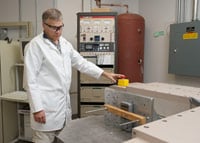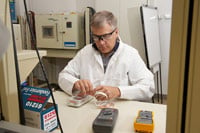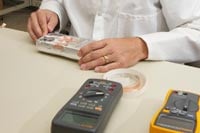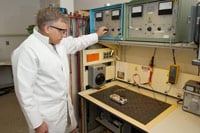
The test subject lies there in silence as Mike Meisner connects the electrodes. He closes the door of the high voltage transient test chamber and steps back.
Then Mike presses the button, sending 8000 volts into the test unit.
More silence. He hits it again. He'll repeat this positive impulse test ten times, then shock the unit under test (UUT) with ten more negative impulses. If it survives all this (it will be stripped down and painstakingly inspected for damage), the UUT will have passed one hurdle on its way to winning a safety rating for use in CAT III/1000V or CAT IV/600V environments.
But many more tests lie ahead. Before a Fluke product earns its rating for safety or performance it may be baked and frozen, drowned in water, choked in a cloud of dust, rattled with vibration, bashed on the floor, and zapped with electricity, again and again.

For electronics technicians, some of those tests may seem unnecessary. Where most technicians work it's unlikely that their tools would have to withstand the extreme conditions Fluke products are tested to. Those are conditions for field electricians and plant maintenance guys. But all technicians, no matter where they work or the conditions they meet, need confidence that their test tools will perform as promised.
Safety is a core issue for Fluke, and the company offers extensive resources and information on electrical measurement safety, including a free video on safe procedures. And safety is a key reason why Mike and the team at Fluke's Product Evaluation and Testing Laboratory in Everett, Washington, keep pushing those buttons.

Safety and reliability
"The electronics technician is probably more interested in the accuracy and the reliability of whatever they're trying to measure," Mike said. "All the testing we do verifies the safety and reliability of the equipment, whether it's for a test technician or any other user of the product."
And though the level of risk may be less for techs working in CAT I or CAT II environments, safety is still important. Safety standards, such as resistance to damage or danger caused by over voltage impulses from lightning or voltage spikes, are set up to ensure safety not just under day-to-day conditions, but when the unexpected happens.
The Fluke Product Evaluation Laboratory is audited regularly to ensure that testing meets the requirements imposed by the national and international authorities and standards. Fluke works with all of the major nationally recognized test labs (NRTLs) including: CSA (Canadian Standards Association), Underwriters Laboratories (UL), TÜV (Technischer Überwachungs-Verein), VDE (Verband Deutscher Elektrotechniker) and self-certification for the CE (European Conformity) symbol. In effect, the several standards agencies recognize the Fluke laboratory's ability to perform and certify testing. Test procedures are laid out in detail and adhered to rigorously. Once a product has passed the appropriate tests, documentation is sent on to the respective agencies for approval and registration. For more about safety standards for electrical measurement, and the agencies that oversee them, see the Fluke application note, "Who sets the rules for electrical testing and safety?" (.pdf)

Testing focuses on two key aspects of product performance: safety and reliability/durability. Product safety is critical. In the impulse testing phase, Fluke multimeters are subjected to repeated jolts of high voltage to prove they can withstand voltage spikes from lightning or other causes without damage to the product or harm to their users. The higher the voltage or measurement category where the product will be used, the higher the test voltage applied—up to 12,000 volts for products designed for CAT IV/1000V environments (see sidebar, "What Does Each Test Show?").




In the dielectric test for multimeter-type tools, the UUT is wrapped in aluminum foil. Voltage is then applied to all the measurement terminals of the product to float the internal components to the test voltage and the foil is grounded, to see if voltage will create a hazard by arcing through the product's enclosure or other accessible location.
Testing to destruction
No detail is too small to check. How the display responds as a meter is switched from one function to the next is important—confusion about which function is active as the dial rotates could be dangerous. If a knob set between two functions triggered both of them at once, that too could be hazardous. Fluke meters are designed to snap decisively from one function to the next, with a definite gap between. The safety lab ensures that a meter does not provide an ambiguous indication to the user.
Passing such tests is vital, but it's not enough. Fluke goes on to test the products to destruction, applying ever higher voltage in the impulse and dielectric tests until, at last, something blows. Then the poor product is disassembled to see what gave way, and how it failed.
"If we've done our calculations correctly we should know exactly where it breaks down," Mike said. "We confirm that the design performs in the way we think it should."
Another battery of tests proves the product meets user expectations for durability and long life. Some of these tests are gateways to certification. For instance, the Fluke 28 II Industrial Multimeter survives a three-meter drop and meets IP 67 standards for protection against intrusion of dust and water. The meter has lived through Fluke's ingress protection (IP) dust chamber, which circulates talcum powder for eight hours while the meter enclosure is subjected to a vacuum of 20 millibars. It also must survive submersion to a depth of one meter in the Fluke water test tank. A careful inspection follows every test to make sure the meter performed as expected, and no dust or water entered the enclosure to compromise the safety of the meter.
"We did a lot of testing in order to figure out how to get it to withstand [submersion] down to one meter," Mike said of the 28 II meter. "We had to learn a lot about gaskets and how to incorporate that into the design."
Each test is precisely set up and calibrated to meet the requirements of the relevant standard. One example is the test setup to verify resistance against water penetration. "One of the things about IP testing is we have to determine the flow rates for each of these products," he said. "Usually it's specified in liters per minute. A liter is a cube 10 centimeters on a side. We can calibrate flow with a caliper."

Science of safety
A specified volume of water flowing through a drip box or falling x meters through an opening, or a column of water exactly one meter deep, produces test conditions that match the requirements set forth in international standards. Drop tests are done using a lab-made drop platform that lets the unit under test fall a precise distance, so it reaches the required velocity as it slams into a wooden slab that has exactly the prescribed density. The UUT is chilled to its minimum operating temperature, dropped the specified distance so all six sides are subjected to the impact, then checked for cracks or other damage.
"You have to be able to explain the science behind it," Mike added. "You have to explain to an auditor how you're performing these tests." Electrical test devices such as those that administer the impulse and dielectric tests are calibrated so their accuracy can be traced back to their respective calibration standards.
The Fluke laboratory serves as a Supervised Maintenance Test (SMT) facility for CSA, which recognizes the tests done there. "They come in and audit us four times a year," Mike said. "They recognize that we know how to do testing. They accept our test results as accurate because our test equipment, laboratory test conditions, and test methods are controlled."
After CSA approves the results, Mike may send the CSA report to UL and TÜV or VDE, if needed, which may accept the results as is and add their certifications, or perform additional tests. The system works because all of these agencies follow the same international safety and test standards.
Only a few products require testing outside the Fluke lab. The Fluke 27 II/Fluke 28 II Industrial Multimeterreceived additional tests and certification from the United States Department of Labor Mine Safety and Health Administration (MSHA), and the Fluke 87V Ex Intrinsically Safe True RMS Multimeter has been tested for use in explosive environments under the European Union ATEX directive for use in explosive atmospheres.
In the end, all of the tests done by Fluke and other labs are summed up in a handful of NRTL symbols on the back of Fluke test products: CSA, UL, TÜV, CE. For users, these could be the most important symbols since they first learned their ABCs.
As Mike Meisner put it, "All of our safety testing is packaged into that little mark."